︎︎︎episode 33
2000’s Trends: Movie Mania! Wes Anderson Wonderland, Sofia Coppola #aesthetics, The Sideways Effect, Napolean Dynamite Dilemma, Amélie and the French Obsession
March 16th, 2021
︎︎︎︎ Listen on Apple
︎︎︎︎ Listen of Spotify
︎︎︎︎ Listen on Stitcher
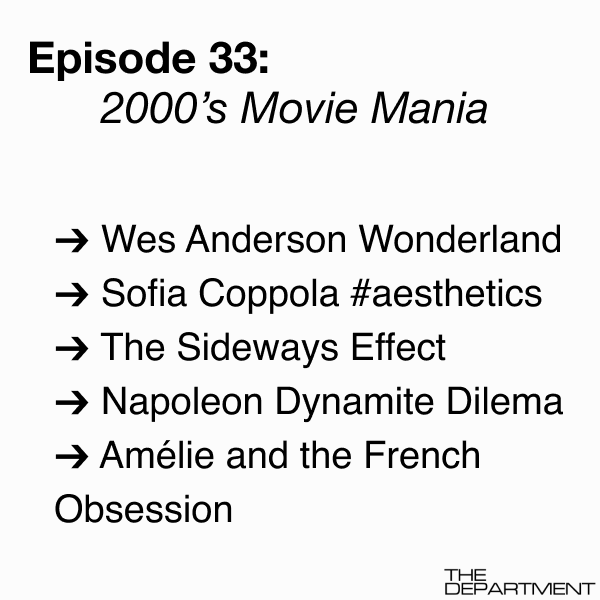
Clubhouse Controversy
Amanda: I wanted to follow up on the conversation with Clubhouse. I’ve been worrying that I’m the only person who’s not feeling it, so I’m glad Chloe agrees! I actually found a Mashable article called “Does anyone actually like Clubhouse?” And a great article from Vulture called “Clubhouse Is Dangerously Close to Becoming Our New Internet Wasteland”
- “It felt less like a cocktail party and more like someone selling me a timeshare.”
- “Everyone talked like they were desperate to network, which isn't really how good networking functions. You don't make connections trading "great point" backslaps, you make them, you know, actually connecting over something meaningful.”
- “there’s also plenty of empty motivational pablum, pseudoscience, chauvinism, colorism, shameless self-promotion, and abject mess”
- Kim did you know that Clubhouse has a $1 billion valuation? My question is: how does Clubhouse end up making money? Selling ads? Selling our info? Selling our conversations?
Movie Mania
Movies drove so many trends- it wasn’t like it was now - Don’t forget we had Video Stores and you watched movies on a DVD player or VHS - Netflix sent you movies like IN THE MAIL. There were way less movies coming out and available. Streaming wasn’t pushing content to your couch constantly. You waited for sometimes 6 months for something to release. Soundtracks were really popular ways to learn about music and you actually bought the soundtrack.
The biggest movies of the year were movies I think are still rather blockbuster legions: Lord of the Rings, Harry Potter, Shrek, Shrek 2 which was bigger than the first Shrek.
But trends come in all shapes and sizes. There were some great indie and off from mainstream films that blew us away and caused serious ripples.
Amélieave this right here

Kim: Amelie came out in 2001 right after 9/11 and became the highest-grossing French film ever released in the US. The movie edited out all the dirt and graffiti and crime and American’s went wild for the Parisian Chic vibes and sparked a new obsession with Francophile amongst white ladies. Montmartre where the film was centralized became a huge tourist destination leading the charge in French fever that is still really popular today and the girl’s name Amelie soared in popularity and continues to be a clever name.
We had a love affair again with the Creme Brulee as the dessert started popping up on menus more and more. And the garden gnome started to see some significance culturally with irreverent Garden Gnome merch reviving and ensured a pop culture status as the key figure in the sports of “gnome-spotting” and “gnome-napping.” A whole marketing ad campaign by Travelocity based on the prank played in the movie surfaced a few years later.
Much like Wes Anderson - this was a movie about the quirk with a centralized “quirky” girl figurehead. And quirky was really popular - especially for outsiders and often the more hipster set who didn’t feel like the mainstream style of Paris Hilton and Britany Spears embodied them - but Paris the country now that was a different story. Women idolized this retro, Parisian chic - midi skirts with clunky black shoes. Simple looks. Minimal but with a splash of color, oh and the cardigans. There isn’t a ton out there about how Amelie changed the landscape of American trends so I am recounting by memory.
The movie was heavily stylized in such a refreshing way embracing Crimson Red and contrasting Kelly Green with notes of Gold. I remember specifically buying and wearing both in colors evocative of this great movie I watched - feeling like these colors were really flattering and exhilarating.
Micro bangs and the pixie type crop was really popular in the indie set. Of course the petite waif as the main character of our affection was just another kink in the 2000s skinny fixation.
ModCloth opened out one year later - featured a rather familiar look.
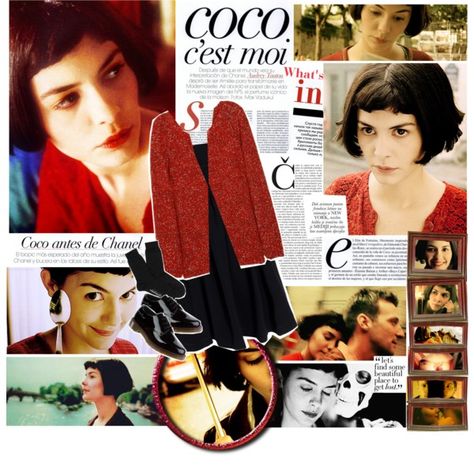
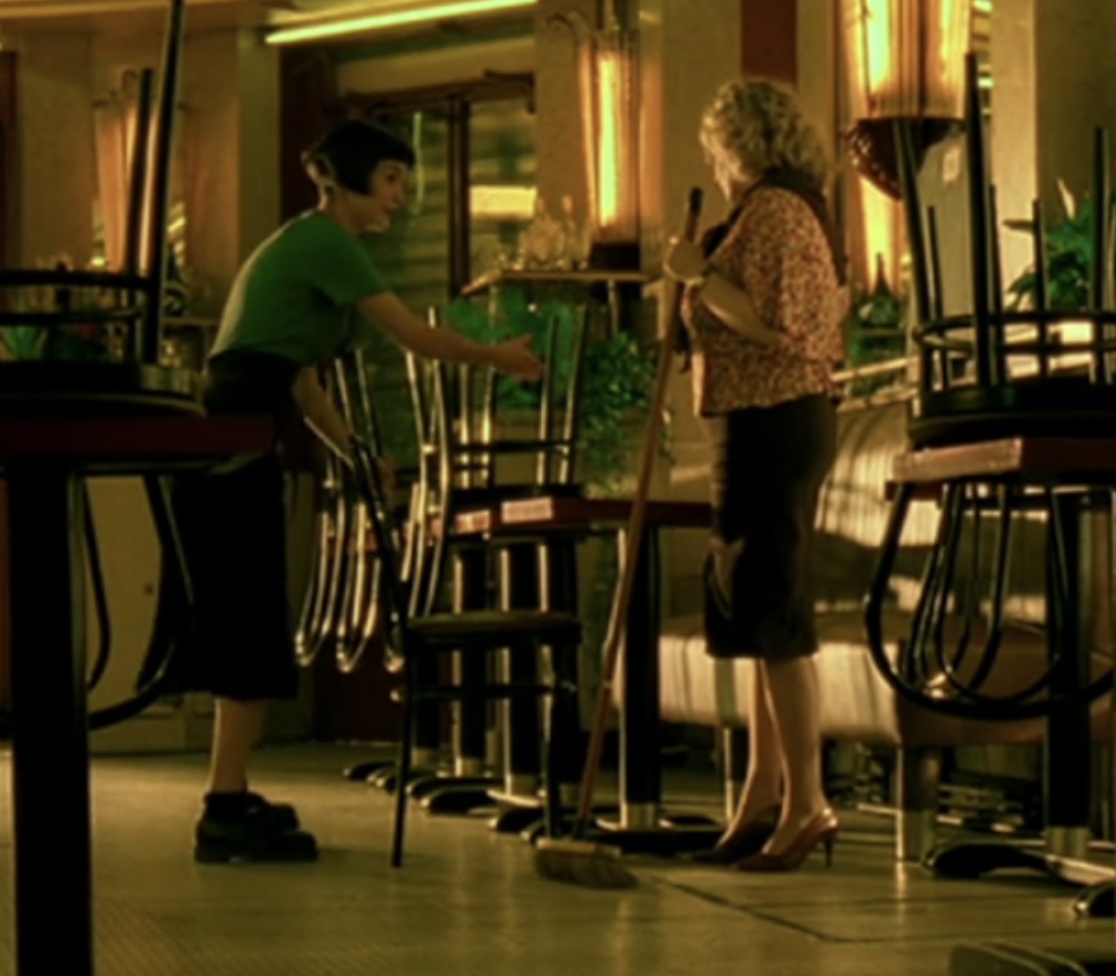
Warping the Wine Industry
How a movie changed the wine industry for decades.
I rewatched Sideways this week - the movie came out in 2004 and was sort of an indie feel but had the backing of the industry and big bucks. I remember it being everywhere. ☺️It featured 2 middle-aged emotionally stunted and absolutely horribly dressed men on a road trip into Santa Barbara adjacent wine country - which was still an under the radar destination and even activity. I do think the movie is still solid - it features Paul Giamatti as this amazingly performed down on his luck divorcee. He is a total wine snob and a writer with an incredible vocabulary. There is just nothing more enjoyable than listening to him pretentiously go through a smug wine tasting with Sandra Oh and describing a wine as “flabby”. Oh and Sandra Oh is wearing one of those curvy metal arm bangles. Do you remember those things?

This movie earned an Academy Award, five Oscar nominations and propelled a lot of careers forward. But what is most fascinating is how much it changed the wine culture and wine industry. It really glamorized the appreciation, culture, experience and activity around wine - changing so many aspects. Although wine culture and enjoyment was on a slow upward trajectory through the 90s and into the aughts, Sideways made really obvious and direct impacts we still see today.
What’s still called “The Sideways Effect” positioned Pinot Noir the underdog of a grape at a point of monumental obsession in California wine country after the movie came out. Paul’s character goes on and on - into an infinite amount of detail about how special the grape is and why it is his favorite - even though it was rare at the time. A wine industry analyst interviewed by NPR states: "Pinot noir production in California has increased roughly 170 percent since Sideways was released." Comparatively California wine grape production was only up about 7 to 8 percent over that same period. Prices for Pinot Noir soared coinciding with the change as demand increased for this underrepresented grape and continues to have a positive connotation to this day. So what was lost during the offset of demand? Well Merlot!
A 2009 study by Sonoma State University found that Sideways slowed the growth in Merlot sales volume and caused its price to fall, but the film's main effect on the wine industry was a rise in the sales volume and price of Pinot Noir and in overall wine consumption.
Merlot which had been extremely popular in the 90s had a small cameo - a single interaction - neigh phrase. It was one of the highest-produced grapes at that time and was everywhere. Paul Giamatti’s character hates merlot, we find out because his Ex-Wife loved it : He yells at his friend outside a restaurant before a double date with two women they meet: "No, if anyone orders merlot, I'm leaving. I am NOT drinking any f****** merlot!" that’s it. That’s what did it - and the merlot industry never bounced back. We go to Silverlake Wine out here and there are only a couple of bottles.
Executive Food & Wine Editor Ray Isle points out, there’s a reason Merlot made for an easy target at the time. “Merlot’s a wonderful grape but if you plant it in the wrong places and overcrop it, you get lots of crappy Merlot, which is basically what was going on around the time of Sideways,” he explains.
Of course the film drove a ton of Sideways loving enthusiasts and new wine interest to the Santa Ynez Valley - which prior to the movie wasn’t as big as Sonoma or Napa. For a few years after the film the wineries in that region had tons of new customers - many not as serious as the original wine lovers, or lots of novices - new to the hobby and learning about grapes and wine.
Beyond that - wine consumption increased overall in the US - with a 30% higher increase in demand from the previous decade and increased average per capita consumption about 25% over 10 years.
Tasting rooms all over became the cool thing to do - Sideways showed this new wine culture and explored a tourist potential. An exciting adult experience with bacchanalian potential.
In the area Wineries were reporting to see a 50-70% increase in traffic - crediting huge leaps in tourism to the movie itself. There was also a boom in small wineries opening up more than before - often half the size as the original larger guys. In the 10 years after Sideways came out the California wine industry saw their number of bonded wineries grow almost 120% - and wine production in the US increased by 22% so most of the wineries that opened were actually smaller, moving away from the standard wholesale system - relying on tourism and their tasting rooms to supply direct sales (basically DTC which has a higher margin).
Neil and I went up to that region this fall - I didn’t even realize that Sideways was based there and had made such a huge impact on that region. Now when I return I would love to visit the places myself - If you want to reminisce there are maps available online and you too - can walk in Pauls’s footsteps and yell about merlot.
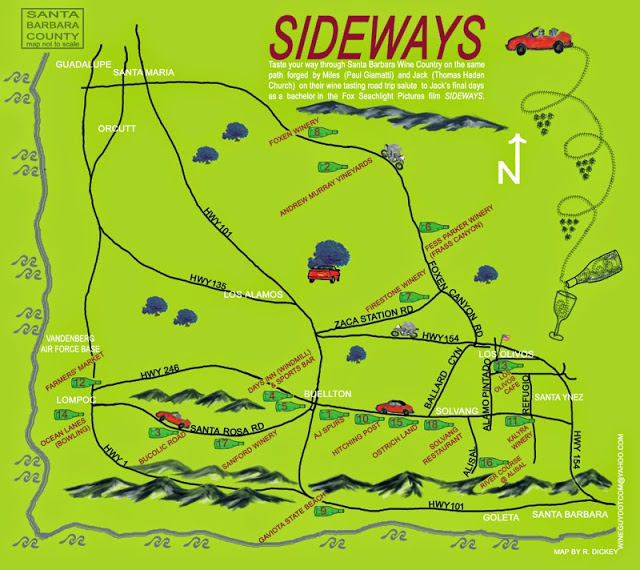
Gosh! Napoleon’s Dynamite
In 2008 the NY Times reported on something called THE “NAPOLEON DYNAMITE'' problem. The year prior in 2007 Netflix which was not a streaming platform that we all know in love today but a Web-based DVD-rental company, was holding a contest to try to improve Cinematch, its “recommendation engine.” The prize: $1 million going to anyone who could make Cinematch’s predictions 10 percent more accurate. But this was proving to be an impossible feat for more than 2 years- over 30K hackers and professional programs had their hands in the contest and were constantly foiled - mainly because of Napoleon Dynamite which was so polarizing it became literally impossible to predict based on what other movies you liked if you would actually like Napoleon Dynamite or just hate it. The goal was to be as close as possible to suggesting your preferences for a fantastic user experience and for the humans on the other side of the screen to continue to trust Netflix. The system is programmed through algorithms to take safe bets on what you would like based on your preferences and a data sets of thousands of ratings and reviews that often showed cohesive correlations which could easily string suggestions together. This does open up the conversion of pre-Netflix experiences and even nostalgia where you would actually go to the video store and potentially talk to the video store clerk (Amanda remember those non-judgy charmers?) or check out the recommendations sections to explore new videos that may never align with any threads a computer program puts together. Giving us as consumers a vastly different and likely more dull experience then if we spoke to a human.
There were a few other movies also embroiled in this issue but the stand out was NP. Other movies messing up the program? The Life Aquatic with Steve Zihus, I heart Huckabees, Lost in Translation and Sideways!

Napoleon Dynamite came out in 2004 with a tiny budget of only $400,000, it became a massive beast pulling in a staggering $46.1 million. Literally overnight it went viral, everyone was quoting every line of dialogue from the film. Plus the quirky “norm core” looks turned Napoleon into a fashion icon.
Why did it hit so dramatically? Well - it was engineered to become a cult classic. After showing at Sundance Fox Searchlight outbid MTV but eventually partnered together for the first time and pulled out all these stops. The ventured into some seriously innovative viral campaigning to essentially release in the marketplace a ready-made cult film. Remember Fan Clubs Amanda??
Well even before the movie release it had amassed a fan club of over 8,000. I stumbled upon a really eye opening article from 2004 that the LA Times released regarding all this from writer Chris Lee. In it he uncovers every tactic they pulled out of their toolkit as they built a cult classic from the ground up.
They distilled the elements of a cult classic and marketing toward that. First by engaging the niche audience of art house movie fans and urban hipsters. Leveraging a website and a “fan club” that encouraged young people to join and get their friends to sign up - in what they equate to a friendster like pyramid scheme. There were also incentives to attend more and more screenings - giving away things like Napoleon Dynamite Chapstick and Vote for Pedro Tshirts.
Additionally they leveraged the quote viralness of the movie - running ads that highlighted key catchphrases
LA Times reported : “To foster an initial cult of personality for “Napoleon Dynamite,” newspaper ads feature wacky snippets of dialogue from the movie like, “Will you bring me my Chapstick? My lips hurt real bad!” intermingled with the obligatory review blurbs. On June 10, MTV began airing television commercials employing the fan club website’s homespun visuals and highlighting such “Napoleon” catchphrases as “Dang!” “Sweet!” and “Idiot!”
Lastly they leveraged MTV’s engaged audience of young people and filmed a series of “interstitial” spots, brief character-based commercials starring the movie’s cast to build awareness and excitement.
So it all worked and not just because of the marketing dollars but that was a big boost. What else had positioned this for cult status?
- First and foremost Nostalgia. This movie celebrated the 80’s and 90’s with an earnest authenticity toward Nostalgia and fashion choices of the misfits to the arguably small town lame cool kids who existed in most all public schools. We all felt a joint recognition, understanding and irony.
- It had a Surreal quality that was being popularized like we had mentioned with Amelie and Wes Anderson - even the cool kids houses look like they were the 90s. All signs point to the fact that this movie was set in the 80s or early 90s but in fact is was supposedly set in 2004. They show Napoleon's student ID at the beginning of the title sequence that shows the school year being 2004-2005 despite the style.
- It was HIGHLY Quotable. Mostly coming from the grumpy, mouth breathing, permed antihero - it resonated. Pre-meme culture people just repeated phrases from shows or movies. The movie also became embedded in meme culture when that started taking off keeping the legacy alive through the years. I would not have wanted to be a Middleschooler when this movie came out - OR have been a teacher! Apparently the quotable nature swept middle schools across the nation like a plague. Because of the lack of swear words and use of soft, nerdy and nostalgic exclamations it was very repeatable and very annoying.
- Nerd triumphalism - its an underdog film based on filmmakers' love of 80’s films like Karate Kid. Napoleon is a beloved spaz with some cool dance skilz. What is not to like?
- The irreverent and nostalgic 80’s and 90’s fashion couldn’t have hit at a better time. Hipster outsiders appreciated his obliviousness. It cashed in in 80’s uncool fashion that was inevitably ironic and therefore cool. A premonition of aughties Normcore.
The Vote for Pedro ringer tee is the gold standard - with iron on red letters reminiscent of little league DIY. From the sweet moon boots, aviator glasses, acid wash dad jeans and tucked in vintage tees - oh and that perm the look invoked a fondness for simpler times.
Interestingly everything was sourced around where it was filmed in Idaho - at regional thrift stores - borrowing the moon boots however from one of the creator’s Jerusha Hess’ uncles named Wally.
The movie heavily featured “Hammer Pants” and dropcrotch started to come back in style - same with Howling Wolf tees and other equestrian fashion wares.
Manrepeller wrote a piece in 2017 dissecting the fashion choices in Napoleon Dynamite as prophecy of then current trend and being way ahead of its time. As Gucci made the nerd cool and geek chic took to the runway. The article likens Napoleon's brother Kip’s kits to Fenty Puma Spring 2018 and Prada.
Hot Topic had the exclusive licence on the “Napoleon'' franchise from January through June - selling TONS of shit as reported by Desert News in 2005. Of course you can imagine the target demographic. Pillow-and-comforter sets, CD holders, buttons, lunchboxes, trading cards, sweat pants, underpants (bikini and thong), shoelaces, magnet sets, lip balm, hats and T-shirts that say everything from "Nessie, Our Underwater Ally" to "I Heart Tater Tots.". The "Vote for Pedro" shirt was the chain's best-selling T-shirt ever. Demand was insanely high and they just kept supplying. They even made dolls.

After about a year of complete Napleonic takeover it was starting to run its course and wear a little thin. Boston Globe's Joanna Weiss reported. "But there are a few reports, from suburbia, of early-stage 'Napoleon'-fatigue. Julie Waxman, a 16-year-old from Easton, said a friend broke up with his girlfriend because she wouldn't stop quoting the movie. Dan Reis, a 17-year-old from Stoughton, sighed that the joke 'gets played out after a while.'"
Wes Anderson Wonderland
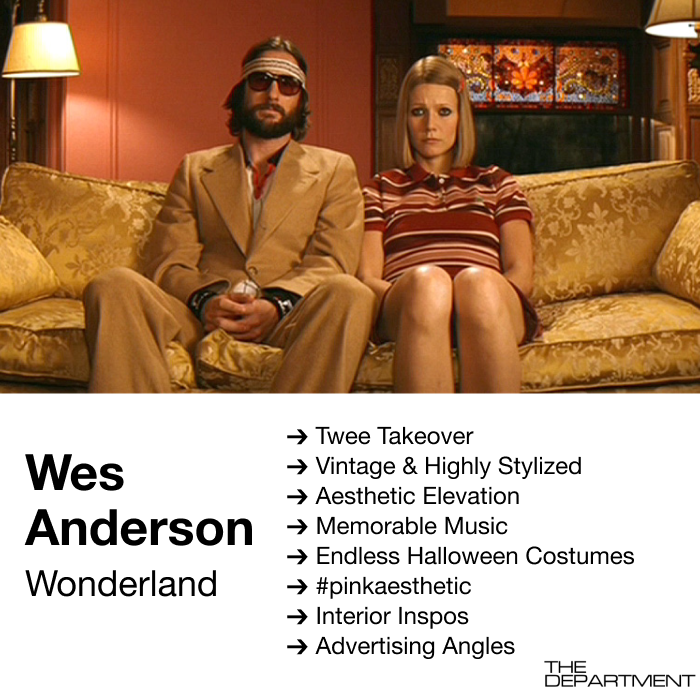
Amanda: I would argue that no director of the 90s and the aughts had as much impact on design, decor, and advertising as Wes Anderson, who released his first movie Bottle Rocket in 1996. This was followed by Rushmore in 1998, which really resonated with me as the kid who was in like fifty different afterschool activities. These movies were quirky, a bit emo, they made stars out of Luke and Owen Wilson, Jason Schwartzman, and they made Bill Murray beloved by a new generation...but Anderson still hadn’t established the design heavy, super twee “world creation” that he would soon be known for. That happened in 2001 with The Royal Tenenbaums, a movie that still moves me. It was a movie with the most perfect soundtrack: two key moments live in my memories completely intact with their musical accompaniment: when Margot and Richie meet at the bus station and Nico’s “These Days” is playing, and when Richie shaves off his hair and attempts suicide while Elliott Smith’s “Needle In the Hay”is playing. JUST SO PERFECT.
This film inspired Halloween costumes for years...a fur coat and some eyeliner to be Margot, a sweatband and a beard for Richie, the matching Adidas tracksuits of Chas and his kids.
But what really stuck with everyone, that made this movie so iconic is every last detail of every set, of every bit of wardrobe, of every scene....Anderson had built an entire, fully fleshed out world for his characters.
Anderson told Dazed in 2012, when asked what he wanted to be when he grew up: “I wanted to be an architect. I don’t even know where I got that idea from. I think I was told ‘you should be an architect’ somewhere early on, and I just latched onto it. My idea of being an architect was envisioning variations of what my room could be, split-level secret chambers, transportation in and out, that sort of stuff. I guess that’s why I enjoy getting to build these fantasy locations.”
The Royal Tenenbaums made Anderson the twee director that shaped that crafty, vintage, quirky aesthetic of the DIY hipsters. The Guardian said (with a certain tone of bitterness,”Over two decades, the meticulous Rushmore auteur has helped spawn an entire sub-genre of American cinema, a landfill site chocca with handlebar moustaches, melancholia and tasteful alt-folk music.”
Anderson made of tons of lovely movies in the aughts and oneward: The Grand Budapest Hotel inspired 9 gajillion #pinkaesthetic posts on Tumblr, Moonrise Kingdom created years of Halloween costumes, as did The Life Aquatic. The Darjeeling Limited took us to India. And I quite enjoyed The Isle of Dogs because it was just SO Japanese.
Anderson’s aesthetic could be found everywhere...from the actual @accidentallywesanderson instagram account, to advertising. There was an oreos ad about a store that only sold tiny oreos, there was an equally weird and twee Oregon healthcare exchange commercial...also Tommy HIlfiger...even a Gucci campaign in 2016. Anderson himself even directed commercials for Ikea and AT&T. If you see something highly stylized, very vintage, and super twee and funny...well, it was influenced by Wes Anderson. In general, many sort of pop culture critics believe that Wes Anderson and his films have influenced an entire generation to curate their personal spaces and their social media presences. I don’t have a problem with that--sometimes it’s just nice to see something cute and nice--but others do. From that same Guardian article: “Accidentally, Wes Anderson’s success bears out a very basic fact, one that critics have to concede: a lot of Anderson is very popular because a lot of it is very pleasing. Taste, though, is a tricky thing, and too much of it can seem suspicious or affected. This certainly applies to Anderson, the perceived high priest of hipsterism and twee. Chances are, if you’ve spent the past decade railing against morons drinking cocktails out of jam jars, you have, in part, been railing against him”
Do we have Wes Anderson to blame for that?
Sofia Coppola #aesthetics
And speaking of super visual, super inspiring, super Tumblr-friendly directors of the aughts...let’s talk about Sofia Coppola! Now there is no doubt that she benefited greatly from nepotism. Her father is Francis Ford Coppola, and she made her film debut as an infant in The Godfather. She also appeared in The Godfather II. But her work in The Godfather III kinda ended her acting career...She was brutally panned for her performance in The Godfather Part III (for which she was named "Worst Supporting Actress" and "Worst New Star" at the 1990 Golden Raspberry Awards). After that she pursued fashion, photography, and painting...sort of trying to find her “thing.’
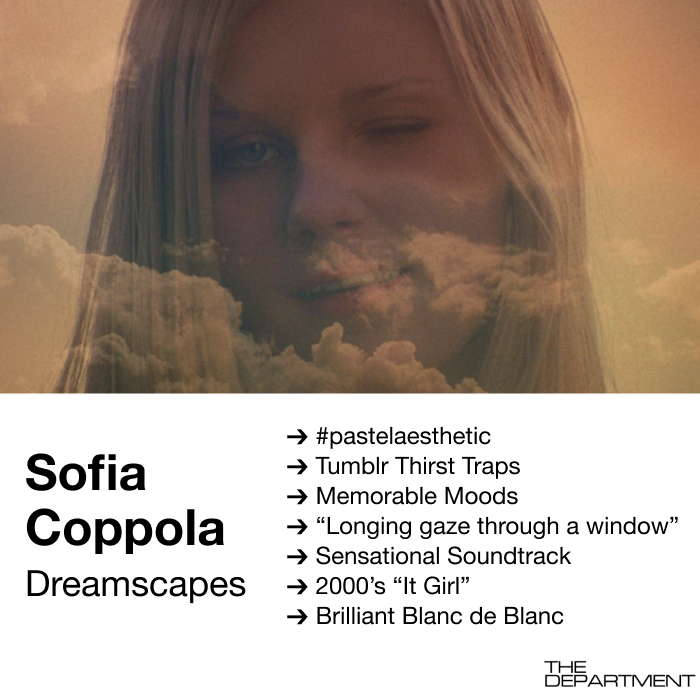
But her debut film just knocked it out of the park. The Virgin Suicides (released in 1999) as the film version of the 1993 novel of the same name by Jeffrey Eugenides. I read this book and I was obsessed. It’s definitely in my top 20 books of all time list. And this might be the first movie that was ever as good as the book. That rarely happens! Here she established her signature elements: tight visual concept that creates a mood, the “longing gaze through a window” and the art of doing most of the storytelling between the lines. Films that are light on dialogue and heavy on dreamlike, meditative imagery.
I found this essay about the film written by Genevieve Koski and I just have to share this description from it:
“The Virgin Suicides takes a similar tack within the less glamorous but no less stuff-filled confines of a suburban 1970s-era Michigan home. The Lisbon girls’ bedrooms are shrines to adolescent girlhood, mixing tokens of their impending womanhood (perfume bottles, makeup, jewelry) and protracted adolescence (childlike toys, trinkets, and drawings) with overt spiritual iconography, much of it Virgin Mary-centric, that calls to both the religious upbringing that keeps them confined, and the story’s broader themes of purity, sin, and worship. (Another telling material symbol that pops up outside their bedrooms: the table display of gilded baby shoes that welcome visitors to the Lisbon home.) None of these connections are vocalized via dialogue, though they do have their roots in Eugenides’ source text. They’re revealed through a studious, judicious deployment of art direction that’s directly traceable to Coppola’s photography and fashion backgrounds.”
The Virgin Suicides had two soundtracks: the primarily 70s music played in pivotal scenes in the movie (including Heart’s “Magic Man” when they introduced the dreamy Trip Fontaine) and the moody dreamlike score created by French duo Air. I mean, you just don’t get cooler than that.
Like Wes Anderson, the devil is in the details. The set design, the wardrobe, the lighting, and the music...these tell the stories as much (or more) than the actual script. Their aesthetics are very different, but they both influenced a generation of creators with the ability to create a mood via visual language.
Coppola followed up The Virgin Suicides with another banger, Lost In Translation, a movie that managed to convey a sense of loneliness in the midst of the world’s largest city, Tokyo. And more Wes Anderson intersection: Bill Murray is in this one! And in true aughts hipster fashion, the soundtrack is tight featuring Air, The Jesus and Mary Chain, Phoenix, and Sebastien Tellier. And there is a scene in a strip club with a Peaches song.
Fun fact: Coppola started filming Lost in Translation without Bill Murray actually being signed...and the entire movie sort of hinged on him agreeing to do it. They were already filming in Japan when he signed on! She is always surprised that people love this film, calling it a“self-indulgent, personal project."
Next was Marie Antoinette...another one of my favorites. More Wes Anderson intersection: Jason Schwartzman is in this one! By this third film, you can see that Coppola is obsessed with a theme: is identity our choice or is thrust upon us? And Marie Antoinette is a great way to explore this idea because her entire life was dictated by her family, her birthright, and her ability to generate heirs.
I love this film so much...the aesthetic, the music, the dreamy lighting...it’s just so on point! And it also inspired tons and tons of tumblr #pastelaesthetic blogs: we see it playing out in tons of aughties fashion/style trends: big hair, pastel hair, faux beauty marks, flower crowns. And I think that the maximalism decor of the sets (filmed at Versailles) are making a comeback now as we move away from minimalism.
Coppola continued to work through the aughties, with The Bling Ring among other things. But nothing every recaptured the mood and aesthetic of her three aughts films.
I will say if you made a Venn diagram of Sofia Coppola and Wes Anderson, the intersecting area would be massive and might just be called TUMBLR AESTHETIC.
